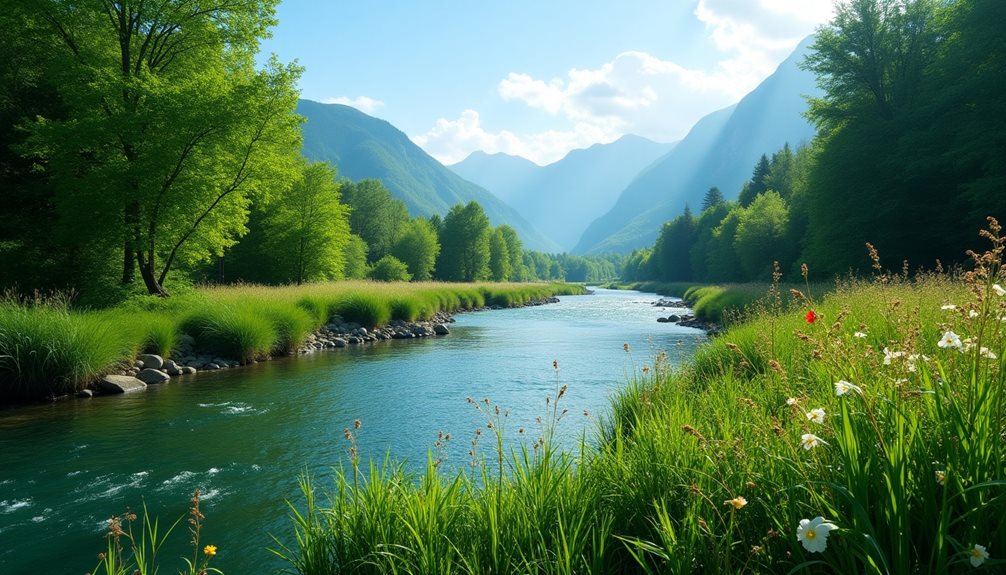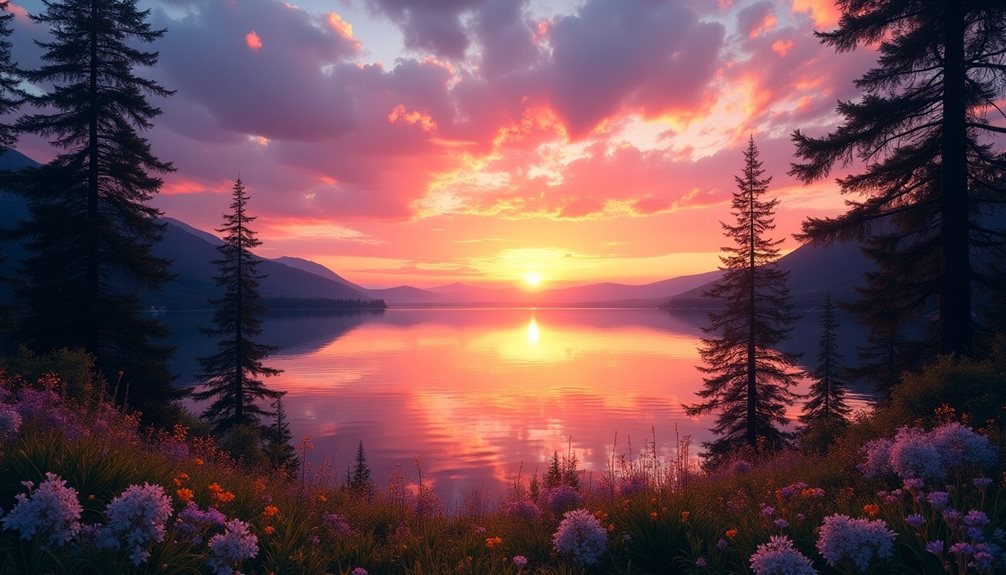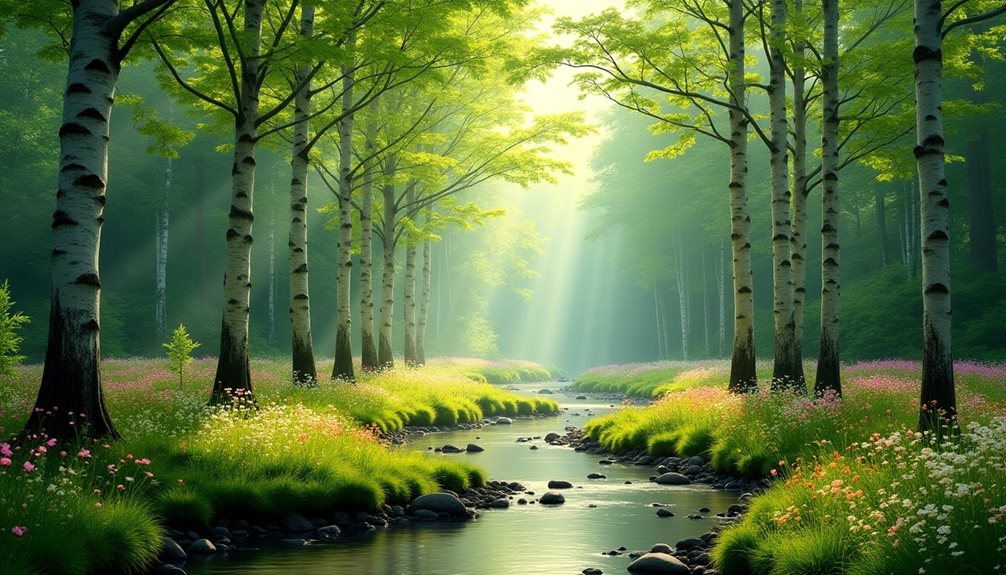Table of Contents
ToggleEssential Nature Vocabulary

Understanding and using essential nature vocabulary is more than just memorizing words—it’s about building a bridge to the natural world, especially in the context of the Russian landscape. Russia, with its vast forests, mighty rivers, majestic mountains, and diverse wildlife, offers a unique setting for anyone eager to engage with nature both intellectually and emotionally.
Mastering nature-related terms enables us to describe the rich tapestry of Russian ecosystems with accuracy and respect. For example, knowing the difference between тайга (taiga) and степь (steppe) reveals the variety of Russian biomes. Words like озеро (lake), река (river), лес (forest), and гора (mountain) become tools for deeper exploration and understanding. This vocabulary isn’t just for scientists or environmentalists—it’s for everyone. When we can name the birds, trees, and landscapes around us, our sense of connection deepens. This awareness naturally leads to greater appreciation and care for the environment.
Nature photography is a cherished tradition in Russia, capturing everything from the quiet beauty of a birch grove to the wild drama of Lake Baikal’s frozen shores. With a strong vocabulary, photographers can better share the stories behind their images—naming the species in a shot, describing weather patterns, or conveying the atmosphere of a place. For instance, a photograph of роса на траве (dew on grass) or закат над тайгой (sunset over the taiga) becomes richer and more evocative when described with precise language. This not only enhances artistic expression but also invites viewers into the world captured through the lens.
A solid grasp of nature vocabulary helps us make thoughtful decisions about how we interact with our surroundings. When reading about conservation efforts, eco-friendly habits, or responsible tourism within Russia’s protected areas, clear terminology ensures we understand what’s at stake. For example, distinguishing between заповедник (nature reserve) and национальный парк (national park) informs our expectations and responsibilities when visiting these places. This knowledge encourages respect for regulations designed to protect fragile environments.
Russian culture has always been closely tied to nature. From literature and folklore to painting and music, references to forests, rivers, and animals abound. Learning and using this vocabulary connects us to generations who found inspiration and comfort in Russia’s landscapes. By embracing essential nature vocabulary, we honor this legacy and contribute to its continuity. We join a community that values the land, respects its resources, and seeks to pass on a healthy environment to future generations.
Building a robust nature vocabulary isn’t just about words—it’s about nurturing a lifelong relationship with the world around us. In the vast and beautiful expanse of Russia, this language is especially vital. It empowers us to speak with clarity, act with purpose, and cherish the natural wonders that define our home.
Common Wildlife Terms
Common wildlife terms play an important role in helping people communicate about conservation and the protection of nature. These words highlight the challenges facing animals and their habitats and show how we can make a difference in preserving biodiversity for future generations.
Endangered Species
An endangered species is a type of animal or plant that is at serious risk of disappearing forever. Causes include habitat destruction, illegal hunting (poaching), pollution, and climate change. Some well-known endangered species are the Amur leopard and the Javan rhino. Conservationists work to protect these species by stopping poaching, restoring habitats, and creating protective laws.
- Russian: исчезающие виды (ees-che-zá-yu-shchee vee-dy) – “endangered species”
- Example: Амурский леопард — один из исчезающих видов.
“The Amur leopard is one of the endangered species.”
![]()
Biodiversity
Biodiversity means the variety of living things in a particular place, including plants, animals, fungi, and even tiny microbes. Healthy ecosystems—like rainforests or coral reefs—have high biodiversity. When biodiversity is lost, ecosystems become weak and can even collapse, which affects all forms of life that depend on them.
- Russian: биоразнообразие (bee-oh-raz-no-oh-bra-zee-ye) – “biodiversity”
- Example: Биоразнообразие важно для устойчивости экосистем.
“Biodiversity is important for ecosystem stability.”
![]()
Habitat Restoration
Habitat restoration means repairing damaged environments so plants and animals can thrive there again. This might include planting native trees, cleaning up pollution, removing invasive species, or rebuilding natural wetlands. Successful habitat restoration has helped animals such as the bald eagle recover from near extinction.
- Russian: восстановление среды обитания (vos-sta-nov-len-ee-ye sre-dý ah-bee-ta-nee-ya) – “habitat restoration”
- Example: Восстановление среды обитания помогает вернуть животных в природу.
“Habitat restoration helps bring animals back into nature.”
![]()
Wildlife Corridors
A wildlife corridor is a protected path or strip of land that connects separate habitats. These corridors allow animals to move safely between areas to find food, mates, and shelter, especially as they migrate or search for resources. Without corridors, roads and cities can trap animals in small areas, putting their survival at risk. Creating wildlife corridors helps species like bears, deer, and elephants travel safely across landscapes.
- Russian: экологический коридор (eh-ko-loh-geech-eskee ko-ree-dor) – “wildlife corridor”
- Example: Экологические коридоры защищают животных от опасностей дорог.
“Wildlife corridors protect animals from road dangers.”
Learning these key terms increases awareness about the importance of conservation and strengthens communication about wildlife protection. Knowing the Russian equivalents—like исчезающие виды, биоразнообразие, восстановление среды обитания, and экологический коридор—also allows for broader discussions about environmental issues around the world.
Flora and Fauna in Russian
Flora and fauna are essential parts of our planet’s ecosystems. The word “flora” refers to all plant life, while “fauna” refers to all animal life found in a particular area. In Russian, these concepts play a significant role not only in language but also in culture and daily life.
Russian Flora (Флора)
Russia is known for its vast landscapes, stretching from tundra to taiga, forests, and steppes. This huge territory means Russia is home to a wide variety of plant life.
- The birch tree – “берёза” (byer-YO-zuh) – is a symbol of Russia and is often found in poetry and songs. Its white bark and delicate leaves are easy to recognize.
- The pine – “сосна” (sas-NAH) – and fir – “ель” (yel’) – are typical coniferous trees found throughout Russian forests.
- In the steppes, you can find grasses like “ковыль” (ka-VYL’), which is feather grass, waving in the wind.
- Many wildflowers grow in Russia, such as “ромашка” (ra-MASH-ka), meaning chamomile, and “василёк” (va-see-LYOK), which is cornflower.
Knowing these names helps you understand Russian nature and culture. For example, “берёзовая роща” (byer-YO-zo-vuh-yuh RO-shuh) means “birch grove,” a common sight in many regions.
Russian Fauna (Фауна)
Russia’s enormous size also means it has an incredible diversity of animal life. The forests, rivers, mountains, and plains are home to many species, both familiar and unique.
- One of the most famous animals is the bear – “медведь” (med-VYED’). The brown bear is a symbol of strength in Russian folklore.
- Wolves – “волк” (volk) – roam the forests and are often mentioned in fairy tales.
- The Siberian tiger – “амурский тигр” (a-MOOR-skee TEE-gr) – lives in the Far East of Russia and is one of the rarest big cats in the world.
- In the skies, you might see an eagle – “орёл” (a-RYOL’) – soaring above mountains and valleys.
- The elk or moose – “лось” (los’) – is another large mammal found in the forests and wetlands.
- In colder areas, you can find the arctic fox – “песец” (pye-SYETS) – with its thick white winter coat.
Other commonly seen animals include hares (“заяц” – ZA-yats), squirrels (“белка” – BYEL-ka), and hedgehogs (“ёж” – YOZH).
Useful Russian Phrases
- “Это берёза.” (EH-tuh byer-YO-zuh) — This is a birch tree.
- “Я видел медведя в лесу.” (ya VEE-dyel med-VYED-ya v li-SOO) — I saw a bear in the forest.
- “В России много разных животных и растений.” (v ra-SEE-ee MNO-ga RAZ-nykh zhi-VOH-tnykh i ras-TYE-nee) — There are many different animals and plants in Russia.
Learning the Russian words for plants and animals not only helps you talk about nature but also gives you insight into the culture, stories, and traditions of Russia. It connects language learning with a deeper appreciation for the natural world.
Natural Landscapes and Features
The stunning diversity of Russia’s natural landscapes and features captivates the imagination and invites exploration.
Russia’s natural landscapes are among the most varied and impressive in the world. For English speakers learning Russian, exploring these features is not only fascinating—it’s also a great way to expand your vocabulary related to geography and nature.
Mountains (Горы, gory)
Russia is home to several famous mountain ranges:
- The Ural Mountains (Уральские горы, urál’skiye góry): These mountains stretch from north to south and are traditionally considered the boundary between Europe and Asia.
- The Caucasus Mountains (Кавказские горы, kavkázskiye góry): Located in the south, they include Russia’s highest peak, Mount Elbrus.
Example vocabulary:
- Гора (gorá) — mountain
- Пик (pik) — peak
- Хребет (khrebyét) — ridge
Rivers and Valleys (Реки и долины, reki i dolíny)
Rivers play a huge part in Russian geography:
- The Volga (Волга, vólga): The longest river in Europe.
- The Lena (Лена, lyéna): One of the largest rivers in Siberia.
Example vocabulary:
- Река (reká) — river
- Долина (dolína) — valley
- Берег (béreg) — bank/shore
Lakes (Озёра, ozyóra)
Russia has many lakes, but Lake Baikal stands out:
- Lake Baikal (Озеро Байкал, ózero baykál): The world’s deepest and oldest freshwater lake.
Example vocabulary:
- Озеро (ózero) — lake
- Глубина (glubiná) — depth
- Пресная вода (présnaya vodá) — fresh water
Taiga Forests (Тайга, taygá)
One of the largest forest areas in the world, taiga is mostly made up of pine, spruce, and larch trees.
Example vocabulary:
- Лес (les) — forest
- Тайга (taygá) — taiga
- Сосна (sasná) — pine tree
- Ель (yel’) — spruce
Useful Russian Terms for Natural Landscapes
| Russian (Cyrillic) | English Phonetic | English Definition |
|---|---|---|
| Гора | gorá | Mountain |
| Река | reká | River |
| Озеро | ózero | Lake |
| Долина | dolína | Valley |
| Лес | les | Forest |
| Тайга | taygá | Taiga forest |
| Пик | pik | Peak |
| Хребет | khrebyét | Ridge |
| Берег | béreg | Shore/Bank |
| Глубина | glubiná | Depth |
| Пресная вода | présnaya vodá | Freshwater |
| Сосна | sasná | Pine tree |
| Ель | yel’ | Spruce |
Learning these terms will help you discuss Russia’s stunning geography in Russian and understand more about its natural world.
Environmental Conservation Language
Conserving the environment depends on a clear grasp of the words and ideas that convey its importance. The language used in environmental conservation highlights the need for urgent action and helps spread awareness about sustainable living. By understanding key concepts, people are better equipped to make informed decisions that benefit both the planet and future generations.
Sustainable Practices
Sustainable practices (устойчивые методы – ustoychivye metody) are ways of living and working that meet today’s needs without damaging the ability of future generations to meet theirs. This includes actions like reducing waste, using water wisely, and supporting local food production. These methods help preserve natural resources (природные ресурсы – prirodnyye resursy) and minimize pollution. For example, crop rotation in farming restores soil nutrients, and using energy-efficient appliances reduces electricity use. Adopting sustainable habits in daily life—such as recycling (переработка – pererabotka), using public transport, and choosing reusable bags—can have a significant positive impact.
![]()
Green Technologies
Green technologies (зеленые технологии – zelenye tekhnologii) refer to innovations designed to reduce harm to the environment. This includes solar panels (солнечные панели – solnechnyye paneli), wind turbines (ветряные турбины – vetryanye turbiny), electric vehicles (электромобили – elektromobili), and systems for purifying water. These technologies aim to lower greenhouse gas emissions (выбросы парниковых газов – vybrosy parnikovykh gazov), conserve energy, and make use of renewable resources. For instance, solar panels convert sunlight into electricity without producing harmful byproducts. Green tech also covers biodegradable materials (биоразлагаемые материалы – bio-razlagaemye materialy), which break down naturally and reduce landfill waste.
![]()
Biodiversity
Biodiversity (биоразнообразие – bioraznoobraziye) is the variety of living organisms, from plants and animals to fungi and microorganisms, found in different ecosystems. A rich biodiversity is vital for maintaining ecological balance (экологическое равновесие – ekologicheskoye ravnovesiye). Forests with diverse species can better withstand pests, diseases, and climate changes. When biodiversity is lost, entire ecosystems can collapse, affecting food security and clean water supplies. Protecting endangered species (охраняемые виды – okhranyaemyye vidy) and preserving habitats (сохранение среды обитания – sokhraneniye sreedy obitaniya) are crucial steps in safeguarding biodiversity.
![]()
Renewable Resources
Renewable resources (возобновляемые ресурсы – vozobnovlyaemyye resursy) are natural materials that regenerate naturally over time. Unlike fossil fuels, which take millions of years to form, resources like sunlight, wind, water, and biomass are constantly replenished. Using renewable energy (возобновляемая энергия – vozobnovlyayemaya energiya) reduces dependence on nonrenewable sources like coal or oil, cutting air pollution and slowing climate change. Hydropower plants (гидроэлектростанции – gidroelektrostantsii), solar farms, and wind parks are practical examples of how societies can shift toward renewable options.
By learning and using these terms—устойчивые методы (ustoychivye metody), зеленые технологии (zelenye tekhnologii), биоразнообразие (bioraznoobraziye), возобновляемые ресурсы (vozobnovlyaemyye resursy)—people can engage more deeply in conversations about conservation. This shared vocabulary strengthens global efforts to protect nature and ensure a healthier future for everyone.
Weather and Climate Terminology

Understanding weather and climate is crucial, especially for those learning about the Russian language and culture. By exploring these terms in both English and Russian, you not only expand your vocabulary but also gain insight into how different societies discuss important environmental topics.
Key Concepts (with Examples)
- Meteorology
The science of atmospheric conditions and weather patterns.
Example: Meteorologists use satellite data to predict storms. - Climate
The average weather conditions of a region over many years.
Example: Siberia has a cold, harsh climate. - Extreme Weather
Severe or unusual weather events, such as hurricanes, droughts, or heatwaves.
Example: Moscow faced an extreme heatwave in 2010. - Greenhouse Gases
Gases (like carbon dioxide and methane) that trap heat in the atmosphere, causing global warming.
Example: Burning coal releases greenhouse gases.
Related Russian Terms Table
| English Term | Russian (Cyrillic) | English Phonetic | English Definition |
|---|---|---|---|
| Meteorology | Метеорология | mete-orologiya | Science of atmospheric phenomena |
| Climate | Климат | klimat | Long-term weather patterns |
| Weather | Погода | pogoda | Day-to-day state of the atmosphere |
| Extreme Weather | Экстремальная погода | ekstremal’naya pogoda | Severe or unusual weather events |
| Greenhouse Gases | Парниковые газы | parnikovyye gazy | Gases that trap heat in the atmosphere |
| Temperature | Температура | temperatura | Degree of heat present in atmosphere |
| Humidity | Влажность | vlazhnost’ | Amount of water vapor in the air |
| Precipitation | Осадки | osadki | Rain, snow, sleet, or hail |
| Forecast | Прогноз | prognoz | Prediction of future weather |
| Drought | Засуха | zasukha | Extended period with little or no rainfall |
| Flood | Наводнение | navodneniye | Overflow of water onto land |
| Wind | Ветер | veter | Air moving from high to low pressure |
With this knowledge, one can better appreciate the natural world and advocate for its protection.
Outdoor Activities and Recreation
Participating in outdoor activities (активности на свежем воздухе – aktivnosti na svezhem vozdukhe) and recreation (отдых – otdykh) supports physical health (физическое здоровье – fizicheskoe zdorovye), mental well-being (психическое благополучие – psikhicheskoye blagopoluchiye), and a lasting appreciation for the natural world (природа – priroda). Studies show that time spent outdoors (на природе – na pri-rode) can lower blood pressure (кровяное давление – krovyanoe davlenie), improve mood (настроение – nastroenie), and reduce stress levels (уровень стресса – uroven’ stressa). Activities such as hiking (пеший туризм – peshy turizm), cycling (велоспорт – velosport), kayaking (каякинг – kayaking), and rock climbing (скалолазание – skalolazaniye) encourage cardiovascular fitness (сердечно-сосудистая форма – serdechno-sosudistaya forma), strength (сила – sila), and endurance (выносливость – vynoslivost’).
Hiking, for example, introduces people to a variety of terrains—mountain paths (горные тропы – gornye tropy), forest trails (лесные тропинки – lesnye tropinki), and coastal walks (прогулки по побережью – progulki po poberezh’yu)—each offering unique sights and challenges. The act of hiking is not only an effective form of exercise (упражнения – uprazhneniya) but also provides opportunities to encounter diverse wildlife (дикая природа – dikaya priroda) and native plants (местные растения – mestnye rasteniya). Research indicates that spending just two hours per week in nature can significantly boost feelings of vitality (жизненная энергия – zhiznennaya energiya) and happiness (счастье – schast’ye).
Camping (кемпинг – kemping) further enriches the outdoor experience by enabling individuals to disconnect from digital distractions and immerse themselves fully in the environment. Modern camping gear (снаряжение для кемпинга – snaryazhenie dlya kempinga), such as lightweight tents (легкие палатки – legkie palatki), portable stoves (портативные плитки – portativnye plitki), and efficient sleeping bags (спальные мешки – spal’nye meshki), makes it easier to explore remote locations safely and comfortably. Nights spent beneath the stars (под звездами – pod zvezdami) have been linked to improved sleep patterns (режим сна – rezhim sna) due to natural light exposure and reduced artificial light.
Nature’s sounds—rustling leaves (шелест листьев – shelest listev), flowing streams (текущие ручьи – tekushchie ruch’i), and nocturnal animals (ночные животные – nochnye zhivotnye)—offer a calming backdrop that is difficult to find in urban settings. Campfires (костры – kostry) provide warmth (тепло – teplo) and a place to gather, fostering social connection (социальная связь – sotsial’naya svyaz’) and storytelling traditions (традиции рассказов у костра – traditsii rasskazov u kostra) that have existed for generations.
Engaging in outdoor recreation also nurtures a sense of environmental stewardship (экологическая ответственность – ekologicheskaya otvetstvennost’). Direct experiences with nature often inspire individuals to support conservation efforts (меры по сохранению природы – mery po sokhraneniyu prirody) and adopt sustainable practices (устойчивые практики – ustoychivye praktiki). According to environmental psychologists (экологи-психологи – ekologii-psikhologi), people who spend more time outdoors are more likely to advocate for the protection of natural spaces (охрана природных территорий – okhrana prirodnykh territoriy).
Overall, outdoor activities offer more than just physical benefits—they cultivate resilience (устойчивость – ustoychivost’), foster community (сообщество – soobshchestvo), and deepen respect for the planet (уважение к планете – uvazhenie k planete).
Ecological Concepts and Terms
Ecology serves as the backbone of understanding the intricate relationships between living organisms and their environments. It encompasses essential concepts that foster awareness and responsibility towards the planet.
Key ecological terms include:
- Biodiversity — The variety of life forms critical for ecosystem resilience (Биоразнообразие /bio-razo-obrazí-ye/).
- Ecological Sustainability Practices — Methods aimed at preserving natural resources for future generations (Экологически устойчивые практики /ekologícheski ustóy-chivye pràktiki/).
- Environmental Impact Assessment — A process to evaluate the potential effects of projects on the environment (Оценка воздействия на окружающую среду /atsénka vozdéystviya na okruzháyushchuyu sredú/).
- Ecosystem Services — The benefits that humans derive from nature, such as clean air and water (Экосистемные услуги /ekosistémnye uslúgi/).
Understanding these concepts empowers individuals to make informed choices that protect the environment and promote sustainability.
Cultural Appreciation of Nature in Russia
Russia’s relationship with nature is deeply rooted in centuries of tradition, spirituality, and daily life. The country’s immense territory, spanning from the taiga forests of Siberia to the steppes of the south and the icy reaches of the north, has shaped a national character that values endurance, resilience, and harmony with the natural world.
Traditional celebrations such as Ivan Kupala Night, held around the summer solstice, are among the most prominent examples of nature-centered festivities. On this night, communities gather to weave flower wreaths, jump over bonfires, and search for the mythical fern flower—customs believed to ensure health, prosperity, and good luck. These rituals, rooted in pre-Christian Slavic beliefs, showcase a longstanding reverence for earth’s cycles and fertility.
Russian literature and art are profoundly influenced by the landscape. Writers like Leo Tolstoy and Ivan Turgenev vividly described forests, fields, and rivers not just as settings but as living characters in their novels. The poetry of Fyodor Tyutchev and Sergei Yesenin often reflects an emotional dialogue with nature, capturing the beauty and power of the Russian countryside. In visual art, painters from the Peredvizhniki movement (The Wanderers) such as Isaac Levitan and Ivan Shishkin became famous for their realistic and evocative depictions of birch groves, meadows, and rural vistas.
Folklore and oral traditions further reveal how central nature is to Russian identity. Tales of forest spirits like the Leshy, water maidens known as Rusalki, and magical animals reflect a worldview where humans coexist with a mysterious, animate landscape. Songs and proverbs frequently invoke natural imagery to express ideas about fate, love, and resilience.
This deep appreciation for nature persists in modern Russia. Protected areas such as Lake Baikal, the world’s deepest freshwater lake, and vast national parks draw both locals and visitors seeking tranquility and inspiration. Many Russians maintain traditions like mushroom picking (known as “тихая охота” or “quiet hunting”), fishing, and dacha gardening, fostering a personal connection to the land.
Ultimately, Russia’s cultural traditions surrounding nature do more than honor the beauty of the environment—they nurture a sense of belonging and continuity, inviting people to experience nature not only as a resource but as a source of meaning and identity.
Frequently Asked Questions
How Can I Practice These Terms Effectively?
To practice effectively, one can utilize flashcard techniques for memorization and engage in nature vocabulary games. These methods enhance retention, making learning enjoyable and fostering a deeper connection with the beauty of the natural world.
Are There Any Apps for Learning Russian Nature Vocabulary?
Many language apps offer engaging vocabulary games designed for learning Russian. These interactive tools not only enhance language skills but also inspire a deeper connection to nature, empowering learners to explore the wilderness with confidence and freedom.
What Are Popular Russian Nature Documentaries?
Popular documentaries featuring wildlife exploration in Russia captivate audiences. Titles such as “Planet Earth” and “Wild Russia” showcase breathtaking landscapes and diverse species, igniting a passion for nature and inspiring viewers to appreciate the planet’s beauty and freedom.
How Do Russians Celebrate Nature-Related Holidays?
Russians celebrate nature-related holidays through vibrant nature festivals and deep-rooted environmental traditions. These occasions inspire communities to connect with the earth, honoring its beauty and fostering a collective commitment to preserving the natural world for future generations.
Where Can I Find Russian Nature-Themed Books?
To discover Russian nature-themed books, one can explore local Russian bookstores or utilize online resources. These platforms offer a rich selection, catering to enthusiasts enthusiastic to connect with nature through literature and expand their knowledge.



